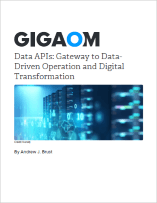Data APIs: Gateway to Data Driven Operation & Digital Transformation (Gigaom Research)

(FREE REPORT)In a recent report from Gigaom Research, Lead Gigaom Analyst Andrew Brust dives deep into the challenge of fragmented organizational data. Bringing more than 25 years of experience as a CTO, analyst, research director and market strategist, Brust peels back the layers on crucial topics for anyone facing integration challenges, including:
- Enterprise data integration
- Traditional APIs
- Databases
- Big data
- Data connectors
- Data APIs
- And digital transformation
Continue reading below, or download the full report.
Summary
Enterprises everywhere are on a quest to use their data efficiently and innovatively, and to maximum advantage, both in terms of operations and competitiveness. The advantages of doing so are taken on authority and reasonably so. Analyzing your data helps you better understand how your business actually runs.
Such insights can help you see where things can improve, and can help you make instantaneous decisions when required by emergent situations. You can even use your data to build predictive models that help you forecast operations and revenue, and, when applied correctly, these models can be used to prescribe actions and strategy in advance.
That today's technology allows business to do this is exciting and inspiring. Once such practice becomes widespread, we'll have trouble believing that our planning and decision-making wasn't data-driven in the first place.
Bumps in the Road
But we need to be cautious here. Even though the technical breakthroughs we've had are impressive and truly transformative, there are some dependencies – prerequisites – that must be met in order for these analytics technologies to work properly. If we get too far ahead of those requirements, then we will not succeed in our initiatives to extract business insights from data.
The dependencies concern the collection, the cleanliness, and the thoughtful integration of the organization's data within the analytics layer. And, in an unfortunate irony, while analytics software has become so powerful, the integration work that's needed to exploit that power has become more difficult.
From Consolidated to Dispersed
The reason for this added difficulty is the fragmentation and distribution of an organization's data. Enterprise software, for the most part, used to run on-premises and much of its functionality was consolidated into a relatively small stable of applications, many of which shared the same database platform. Integrating the databases was a manageable process if proper time and resources were allocated.
But with so much enterprise software functionality now available through Software as a Service (SaaS) offerings in the cloud, bits and pieces of an enterprise's data are now dispersed through different cloud environments on a variety of platforms. Pulling all of this data together is a unique exercise for each of these cloud applications, multiplying the required integration work many times over.
Even on-premises, the world of data has become complex. The database world was once dominated by three major relational database management system (RDBMS) products, but that's no longer the case. Now, in addition to the three commercial majors, two open source RDBMSs have joined them in Enterprise popularity and adoption. And beyond the RDBMS world, various NoSQL databases and Big Data systems, like MongoDB and Hadoop, have joined the onpremises data fray.
A Way Forward
A major question emerges. As this data fragmentation is not merely an exception or temporary inconvenience, but rather the new normal, is there a way to approach it holistically? Can enterprises that must solve the issue of data dispersal and fragmentation at least have a unified approach to connecting to, integrating, and querying that data? While an ad hoc approach to integrating data one source at a time can eventually work, it's a very expensive and slow way to go, and yields solutions that are very brittle.
In this report, we will explore the role of application programming interfaces (APIs) in pursuing the comprehensive data integration that is required to bring about a data-driven organization and culture. We'll discuss the history of conventional APIs, and the web standards that most APIs use today. We'll then explore how APIs and the metaphor of a database with tables, rows, and columns can be combined to create a new kind of API. And we'll see how this new type of API scales across an array of data sources and is more easily accessible than older API types, by developers and analysts alike.
... Continue Reading the Report
Table of Contents
- Summary
- Integration 360: Essential for Data-Driven Enterprises
- Enter the API
- The SQL/Database Comfort Zone
- Data Connectors as APIs
- Database Metaphor + API = Data API
- Data APIs: The Path to Digital Transformation
- Copyright





